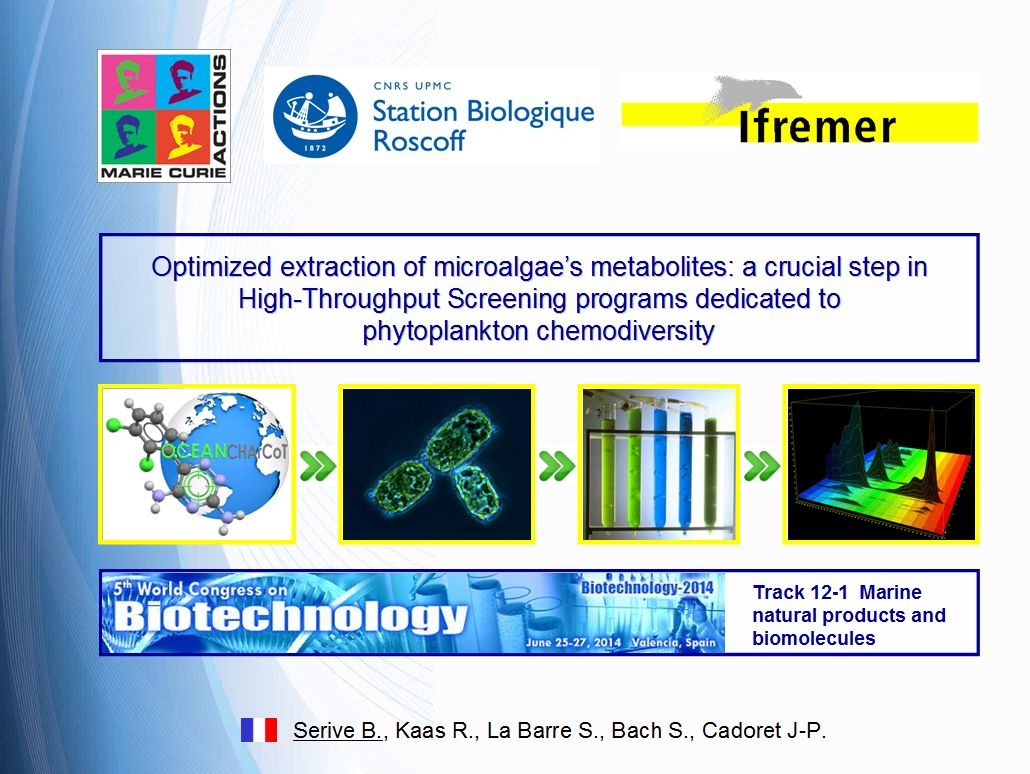Benoît Serive
CV web Benoît Serive
Entrepreneur
Pharmacognosie marine
Biologie marine
Biotechnologie marine
43 ans
Permis de conduire
Freelance
En simple veille
Lauréat du Prix de la vocation 2006
Lauréat 2013 Bourse Marie Curie IOF Programme OCEANCHArCoT
Membre du Réseau Francophone de Métabolomique et de Fluxomique
Membre de l'Association Francophone pour l'Enseignement et la Recherche en Pharmacognosie
Membre de l'American Society of Pharmacognosy
Membre de l'Association for the Sciences of Limnology and Oceanography
Reviewer pour les journaux
Marine Drugs et Algal Research
Invité au congrès Végétaux aquatiques : écologie et bénéfices (Porquerolles, octobre 2013)
Conférencier invité au 5ème Congrès International des Biotechnologies
(Valence, Espagne, Juin 2014)
En quelques mots :
Volontaire, passionné et sensible au respect des valeurs humaines, je souhaite mettre mes compétences au service de la recherche de molécules à haute valeur ajoutée issues de la biodiversité marine.
Domaine d'intérêt :
A l'interface entre l'océanographie biologique et la pharmacognosie marine
Palme d'or du superviseur érudit, bienveillant et intègre décernée à :
Prof. Ronald J. QUINN
(Griffith Institute for Drug Discovery, Brisbane, Australie)
Mentor inspirant :
Prof. émérite Jean-Michel KORNPROBST
(Université de Nantes)
Lauréat 2013 Bourse Marie Curie IOF Programme OCEANCHArCoT
Membre du Réseau Francophone de Métabolomique et de Fluxomique
Membre de l'Association Francophone pour l'Enseignement et la Recherche en Pharmacognosie
Membre de l'American Society of Pharmacognosy
Membre de l'Association for the Sciences of Limnology and Oceanography
Reviewer pour les journaux
Marine Drugs et Algal Research
Invité au congrès Végétaux aquatiques : écologie et bénéfices (Porquerolles, octobre 2013)
Conférencier invité au 5ème Congrès International des Biotechnologies
(Valence, Espagne, Juin 2014)
En quelques mots :
Volontaire, passionné et sensible au respect des valeurs humaines, je souhaite mettre mes compétences au service de la recherche de molécules à haute valeur ajoutée issues de la biodiversité marine.
Domaine d'intérêt :
A l'interface entre l'océanographie biologique et la pharmacognosie marine
Palme d'or du superviseur érudit, bienveillant et intègre décernée à :
Prof. Ronald J. QUINN
(Griffith Institute for Drug Discovery, Brisbane, Australie)
Mentor inspirant :
Prof. émérite Jean-Michel KORNPROBST
(Université de Nantes)
With the recent development of state-of-the-art technologies (e.g hyphenated MS techniques) and methodologies (e.gdereplication), the scientific community is interested in the exploration of poorly chemically studied bioresources. The high diversity of interacting phytoplankton species suggests an important and highly diverse chemical repertoire (e.gisoprenoids, toxins, polysaccharides, PUFAs, oxylipins, phycobiliproteins) which may inspire applications in health, nutrition and biotechnology. Biosynthesis of these metabolites is strongly dependent upon their environment/culture conditions which may be investigated using OMICS approaches. In microalgae, a major bottleneck isthe difficulty in extracting deeply inaccessible molecules, an important issue that demands adapted solutions prior to considering High-Throughput Screening (HTS). Bioactive minority metabolites may pass unnoticed on spectra and thus require special attention. The extraction of metabolites may prove difficult due to the presence of highly resistant cell walls (Phaeodactylumtricornutum), or of exopolysaccharidic secretions surrounding the cell membrane (Porphyridiumpurpureum). The Mix Mill process (vibrating microbeads) which gave excellent extraction yields without chemical alteration of the analytes) and is fully compatible with HPLC and LC-MS analysis was optimised. Being accurate, simple to operate, rapid, safe and preserving sensitive molecules, makes the Mix Mill process suitable for the screening of microalgalchemodiversity. This methodology was applied in the Photomer, and currently in OCEANOMICs and OCEANCHArCoT programs, all being dedicated to the identification of new marine metabolites with high added value. Finally, this methodology represents a significant improvement in the field of OMICS studies from microalgae, as it provides the most representative estimate of their exploitable chemical diversity.
Date de création
26 juin 2014
